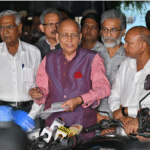Introduction
UGC Draft Regulation, India’s higher education regulatory body, recently proposed a draft regulation on faculty appointments that has sparked widespread criticism from student unions, UGC Draft Regulation teachers’ associations, and education experts. While the draft aims to standardize hiring practices and promote meritocracy, critics argue that it undermines institutional autonomy, diminishes faculty diversity, and poses challenges to equitable access to education.
This article examines the details of the UGC’s proposed regulation, UGC Draft Regulation the concerns raised by stakeholders, and the implications for India’s higher education landscape.
Overview of the UGC Draft Regulation
1. Key Provisions of the Draft Regulation
The draft regulation introduces significant changes to the faculty recruitment process:
- Centralized Recruitment Exams: Proposes the introduction of a centralized test for faculty appointments across central and state universities.
- Ph.D. Requirement: Reinforces that a Ph.D. will remain mandatory for faculty positions in universities, while postgraduate qualifications may suffice for certain college-level posts.
- Streamlined Interviews: Outlines uniform interview guidelines to reduce subjective biases in faculty selection.
- Reservation Compliance: Seeks stricter adherence to reservation norms to ensure representation of marginalized communities.
2. UGC’s Justification
The UGC has defended the draft regulation as a means to bring transparency and standardization to faculty appointments. It argues that the centralized approach will curb nepotism and enhance the quality of teaching and research.
Concerns Raised by Teachers and Students
Despite the UGC’s stated intentions, student bodies, teachers’ associations, and experts have raised several concerns.
1. Undermining Institutional Autonomy
Teachers argue that the new regulation dilutes the autonomy of universities, particularly in faculty appointments. Institutions have historically determined hiring criteria based on their unique academic focus, UGC Draft Regulation needs, and priorities.
- Teachers’ Perspective: “The centralized test disregards the individuality of academic institutions. It treats universities like factories, ignoring their diverse specializations,” said a senior professor from Jawaharlal Nehru University (JNU).
2. Increased Dependence on Exams
Both teachers and student unions oppose the heavy reliance on centralized exams, emphasizing that standardized tests cannot comprehensively assess a candidate’s teaching ability, research aptitude, UGC Draft Regulation and interdisciplinary knowledge.
- Students’ Union Leader: “Not every academic skill can be quantified through exams. Teaching requires creativity, mentorship, and passion, which no test can measure adequately.”
3. Barriers to Diversity in Hiring
Critics have also flagged concerns about diversity:
- Regional Representation: A centralized system might favor candidates from certain regions or institutions, potentially marginalizing applicants from less resourceful backgrounds.
- Socio-economic Barriers: Candidates from marginalized groups may face disproportionate challenges in preparing for nationwide competitive exams due to unequal access to educational resources.
 For the more information click on this link
For the more information click on this link
4. Reservation Challenges
Although the draft regulation reiterates reservation compliance, past instances suggest that merely codifying such measures doesn’t ensure implementation.
- Underrepresentation: Critics point out the consistent underrepresentation of Scheduled Castes (SC), Scheduled Tribes (ST), and Other Backward Classes (OBC) in faculty positions despite mandated quotas.
Reaction from Teacher Associations
Leading teachers’ organizations have voiced strong opposition to the draft regulation.
1. Teachers’ Federation of India (TFI)
The TFI has released a statement urging the UGC to withdraw the draft regulation, UGC Draft Regulation arguing that it centralizes decision-making and erodes academic freedom.
- “Universities need the ability to make independent hiring decisions to foster innovation and diversity,” said a TFI spokesperson.
2. Federation of Central University Teachers’ Associations (FEDCUTA)
FEDCUTA has called for an immediate review of the regulation, UGC Draft Regulation stressing the need for stakeholder consultation before implementing sweeping changes. The organization is particularly concerned about the negative impact on pedagogical innovation due to uniform hiring criteria.
Student Protests and Demands
1. National-Level Protests
Several student unions, including the All India Students’ Association (AISA) and the Students’ Federation of India (SFI), have held protests across campuses, condemning the draft.
- AISA Statement: “The regulation serves elite interests, disregards equitable access, UGC Draft Regulation and reduces opportunities for marginalized candidates.”
2. Demand for Inclusive Processes
Students demand a recruitment process that balances merit with equitable access, UGC Draft Regulation recognizes regional diversity, and includes provisions for special consideration of marginalized groups and women candidates.
Comparison with Global Practices
The proposed centralized test raises questions about its alignment with global best practices:
- United States: Faculty recruitment processes prioritize research portfolios, interviews, teaching demonstrations, and institutional fit rather than national standardized exams.
- United Kingdom: Hiring is typically handled at the university level, focusing on a candidate’s ability to contribute to institutional priorities, such as innovative teaching and societal impact.
- Japan: While centralized education systems exist, UGC Draft Regulation faculty hiring still emphasizes collaboration between departments and institutional needs.
Experts argue that India must tailor its policies to fit its socio-cultural complexities rather than mimicking homogenized systems.
Impact on Higher Education Quality
Proponents of the regulation argue that standardized tests will enhance teaching quality by ensuring a consistent pool of qualified candidates. Critics, however, foresee adverse consequences:
- Reduced Creativity: The focus on standardized metrics may discourage innovative thinkers from pursuing academia.
- Rigid Criteria: Institutions could lose flexibility in selecting faculty aligned with their unique pedagogical styles.
The UGC’s Next Steps
Following backlash from various quarters, the UGC has indicated a willingness to engage with stakeholders.
- Consultation Process: The UGC Chairperson has invited suggestions and feedback on the draft to address concerns.
- Possible Revisions: Officials suggest that the final regulation might include exceptions or adaptations to better suit diverse academic institutions.
Voices from Academia
Interviews with educators and students further illuminate the challenges and potential solutions:
- Dr. Meera Pillai, Academic at Delhi University: “We need reforms, UGC Draft Regulation but they should empower institutions rather than centralize control. Let universities determine the best criteria for their academic culture.”
- Raj Malhotra, Ph.D. Aspirant: “For candidates like me from rural backgrounds, the centralized system feels like an additional barrier. It’s discouraging.”
 For the more information click on this link
For the more information click on this link
Path Forward: Balancing Standardization and Diversity
While the draft regulation aims to streamline and improve faculty appointments, UGC Draft Regulation its reception underscores the need for balancing centralization with inclusivity and diversity.
1. Inclusive Standardization
- Develop guidelines that standardize basic criteria while leaving room for institutional discretion.
2. Support for Marginalized Candidates
- Introduce capacity-building programs for candidates from underrepresented groups to ensure equal footing in centralized processes.
3. Ongoing Review Mechanisms
- Establish a dynamic feedback and review mechanism to adapt regulations based on evolving challenges and stakeholder input.
Conclusion
The UGC’s draft regulation on faculty appointments has opened a crucial dialogue about the future of Indian higher education. While its intent to improve transparency and quality is commendable, UGC Draft Regulation the widespread concerns it has raised highlight the complexities of implementing one-size-fits-all policies in a diverse educational ecosystem.
As students, teachers, and policymakers engage in constructive discussions, the focus must remain on ensuring equitable opportunities, academic excellence, UGC Draft Regulation and the autonomy of India’s institutions of higher learning. Only then can meaningful reforms align with the vision of a truly inclusive and innovative education system. ALSO READ:- Dense Fog Blankets Delhi as Temperature Drops to 9°C; Air Quality Stagnates in ‘Poor’ Category 2025





